Application of Phase Transfer Catalysis in the Esterification of Organic Acids: The Primary Products from Ring Hydrocarbon Oxidation Processes
Abstract
1. Introduction
2. Results and Discussion
2.1. Esterification of Adipic Acid, Phthalic Acid, and Benzoic Acid
2.2. Kinetics Study of the Esterification Process
2.2.1. Effects of Temperature on the Esterification of Adipic Acid
2.2.2. Effects of the Amount of Water on the Esterification of Adipic Acid
2.2.3. Effects of the Amount of TBAB on the Esterification of Adipic Acid
2.2.4. Effects of the Types of the Catalysts on the Esterification of Adipic Acid
2.2.5. Effect of Different Organic Acids on the Esterification Process
2.2.6. Esterification Processes
- (1)
- mass transfer process: the anion of adipic acid combines with the cation of the catalyst to form the active ion pair, which is transferred from water phase to organic phase;
- (2)
- chemical reaction process in organic phase: reactive ions transferred to organic phase react with 1-bromobutane to form the final product dibutyl adipate.
3. Experimental
3.1. Chemicals
3.2. Experimental Design
3.3. PTC Process Evaluation
4. Conclusions
Supplementary Materials
Author Contributions
Funding
Conflicts of Interest
References
- Occelli, M.L. Fluid Catalytic Cracking VII: Materials, Methods and Process Innovations. In Studies in Surface Science and Catalysis; Elsevier Science: Amsterdam, The Netherlands, 2007; Volume 166, pp. 1–319. [Google Scholar]
- Rosinski, G.; Olsen, C. Cetane Improvement in Diesel Hydrotreating. In ART Catalagram® 106 Special Edition; Advanced Refining Technologies LLC.: Chicago, IL, USA, 2009; pp. 12–16. [Google Scholar]
- Chang, J.R.; Chang, S.L.; Lin, T.B. γ-Alumina-Supported Pt Catalysts for Aromatics Reduction: A Structural Investigation of Sulfur Poisoning Catalyst Deactivation. J. Catal. 1997, 169, 338–346. [Google Scholar] [CrossRef]
- Jacquin, M.; Jones, D.J.; Rozière, J.; López, A.J.; Rodríguez-Castellón, E.; Trejo Menayo, J.M.; Lenarda, M.; Storaro, L.; Vaccari, A.; Albertazzi, S. Cetane improvement of diesel with a novel bimetallic catalyst. J. Catal. 2004, 228, 447–459. [Google Scholar] [CrossRef]
- Sidhpuria, K.B.; Parikh, P.A.; Bahadur, P.; Jasra, R.V. Rhodium Supported Hβ Zeolite for the Hydrogenation of Toluene. Ind. Eng. Chem. Res. 2008, 47, 4034–4042. [Google Scholar] [CrossRef]
- Sidhpuria, K.B.; Patel, H.A.; Parikh, P.A.; Bahadur, P.; Bajaj, H.C.; Jasra, R.V. Rhodium nanoparticles intercalated into montmorillonite for hydrogenation of aromatic compounds in the presence of thiophene. Appl. Clay Sci. 2009, 42, 386–390. [Google Scholar] [CrossRef]
- Taillades-Jacquin, M.; Jones, D.J.; Rozière, J.; Moreno-Tost, R.; Jiménez-López, A.; Albertazzi, S.; Vaccari, A.; Storaro, L.; Lenarda, M.; Trejo-Menayo, J.-M. Novel mesoporous aluminosilicate supported palladium-rhodium catalysts for diesel upgrading: II. Catalytic activity and improvement of industrial diesel feedstocks. Appl. Catal. A-Gen. 2008, 340, 257–264. [Google Scholar] [CrossRef]
- Stanislaus, A.; Cooper, B.H. Aromatic Hydrogenation Catalysis: A Review. Catal. Rev. 1994, 36, 75–123. [Google Scholar] [CrossRef]
- Ren, R.; Yang, H.; Zheng, Y.; Ng, S.; Zhao, J. Oxidative Ring-Opening of 2-Methylcyclohexanone Catalysed by Supported Heteropolyacid Catalysts for Cetane Number Enhancement. Can. J. Chem. Eng. 2013, 91, 776–782. [Google Scholar] [CrossRef]
- Xu, C. Organic Chemistry, 2nd ed.; China Higher Education Press: Beijing, China, 2002. [Google Scholar]
- Sun, C.; Wang, X.; Chen, T.; Sun, Q.; Ma, L.; Sun, F.; Sun, Z.; Sun, X.; Li, Q.; Yu, G.; et al. Principle and Application of Organic Oxidation Reactions; Chemical Industry Press: Beijing, China, 2013. [Google Scholar]
- Ma, S.; Zhang, J. 2,3,4-or 2,3,5-Trisubstituted Furans: Catalyst-Controlled Highly Regioselective Ring-Opening Cycloisomerization Reaction of Cyclopropenyl Ketones. J. Am. Chem. Soc. 2003, 125, 12386–12387. [Google Scholar] [CrossRef] [PubMed]
- Trost, B.M.; Ornstein, P.L. Ferric Salt Catalysed Oxygenation of Cycloalkanones to Oxo Esters by Molecular Oxygen. J. Org. Chem. 1983, 48, 1133–1135. [Google Scholar]
- Ali, B.E.; Bregeault, J.M.; Martin, J.; Martin, C. Oxidative Cleavage of Ketones by Vanadium Polymetalates and Dioxygen. New J. Chem. 1989, 13, 173–175. [Google Scholar]
- Ali, B.E.; Bregeault, J.M.; Mercier, J.; Martin, J.; Martin, C.; Convertb, O. The Oxidation of Ketones with a Heteropolyacid, H5[PMo10V2O40] and Dioxygen. J. Chem. Soc. Chem. Commun. 1989, 62, 825–826. [Google Scholar] [CrossRef]
- He, L.; Kanamori, M.; Horiuchi, C.A. Oxidation of 2-Alkylcycloalkanones with Iodine-Cerium (IV) Salts in Alcohols. J. Chem. Res. 1999, 2, 122–123. [Google Scholar] [CrossRef]
- Bregeault, J.M.; Launaya, F.; Atlamsani, A. Catalytic Oxidative Carbon–Carbon Bond Cleavage of Ketones with Dioxygen: Assessment of Some Metal Complexes. Acc. Acad. Sci. Ser. IIC Chem. 2001, 4, 11–26. [Google Scholar]
- Bloss, C.; Wagner, V.; Jenkin, M.E.; Volkamer, R.; Bloss, W.J.; Lee, J.D.; Heard, D.E.; Wirtz, K.; Martin-Reviejo, M.; Rea, G.; et al. Development of a detailed chemical mechanism (MCMv3.1) for the atmospheric oxidation of aromatic hydrocarbons. Atmos. Chem. Phys. 2005, 5, 641–664. [Google Scholar] [CrossRef]
- Greenberg, A. Exploration of Selected Pathways for Metabolic Oxidative Ring Opening of Benzene Based on Estimates of Molecular Energetics. In Active Oxygen in Biochemistry; Valentine, J.S., Foote, C.S., Greenberg, A., Liebman, J.F., Eds.; Springer: Dordrecht, The Netherlands, 1995; pp. 401–432. [Google Scholar]
- Hoffmann, E.H.; Tilgner, A.; Wolke, R.; Boge, O.; Walter, A.; Herrmann, H. Oxidation of substituted aromatic hydrocarbons in the tropospheric aqueous phase: Kinetic mechanism development and modeling. Phys. Chem. Chem. Phys. 2018, 20, 10960–10977. [Google Scholar] [CrossRef] [PubMed]
- Yang, Y.; Boehman, A. Oxidation chemistry of cyclic hydrocarbons in a motored engine: Methylcyclopentane, tetralin, and decalin. Combust. Flame 2010, 157, 495–505. [Google Scholar] [CrossRef]
- Wang, B.; Wang, J.; Ma, H. Synthesis of Linear Alkane (C14–C28) from Cyclohexane with V-Promoted Sulfated ZrO2 Under Mild Conditions. Energy Fuel 2008, 22, 218–222. [Google Scholar] [CrossRef]
- Tailleur, R.G.; Caris, P.C. Selective Oxidation of a Hydrotreated Light Catalytic Gas Oil to Produce Low-Emission Diesel Fuel. Energy Fuel 2009, 23, 799–804. [Google Scholar] [CrossRef]
- Chidambaram, M.; Sonavane, S.U.; de la Zerda, J.; Sasson, Y. Didecyldimethylammonium bromide (DDAB): A universal, robust, and highly potent phase-transfer catalyst for diverse organic transformations. Tetrahedron 2007, 63, 7696–7701. [Google Scholar] [CrossRef]
- Leng, Y.; Wang, J.; Zhu, D.R.; Ren, X.Q.; Ge, H.Q.; Shen, L. Heteropolyanion-Based Ionic Liquids: Reaction-Induced Self-Separation Catalysts for Esterification. Angew. Chem. Int. Ed. 2009, 48, 168–171. [Google Scholar] [CrossRef]
- Yang, H.M.; Chen, C.H. Catalytic esterification of sodium salicylate in third-liquid phase under ultrasound-assisted tri-liquid phase-transfer catalysis. J. Mol. Catal. A-Chem. 2009, 312, 107–113. [Google Scholar] [CrossRef]
- Coleman, M.T. Use of diethoxymethane as a solvent for phase-transfer esterification of carboxylic acids. Synth. Commun. 2012, 42, 1911–1913. [Google Scholar] [CrossRef]
- Starks, C.M.; Liotta, C.L.; Halpen, M. Phase-Transfer Catalysis: Fundamentals, Applications, and Industrial Perspective; Chapman & Hall: New York, NY, USA, 1994. [Google Scholar]
- Zahalka, H.A.; Sasson, Y. Esterificantion of 1,4-dichlorobutane with sodium formate under solid-liquid phase transfer catalysis. A kinetic study. Can. J. Chem. 1989, 67, 245–249. [Google Scholar] [CrossRef]
- Yang, H.; Huang, C. Kinetics for benzoylation of sodium phenolide by liquid-liquid phase-transfer catalysis. Appl. Catal. A-Gen. 2006, 299, 258–265. [Google Scholar] [CrossRef]
- Rabinovitz, M.; Cohen, Y.; Halpern, M. Hydroxide ion initiated reactions under phase transfer catalysis conditions: Mechanism and implications. New synthetic methods. Angew. Chem. Int. Ed. 1986, 25, 960–970. [Google Scholar] [CrossRef]
- Makosza, M.; Krylowa, L. Remarks on the mechanism of phase-transfer catalyzed carbanion generation in two-phase systems. Tetrahedron 1999, 55, 6395–6402. [Google Scholar] [CrossRef]
- Wang, H.; Lin, H.; Feng, P.; Han, X.; Zheng, Y. Integration of catalytic cracking and hydrotreating technology for triglyceride deoxygenation. Catal. Today 2017, 291, 172–179. [Google Scholar] [CrossRef]
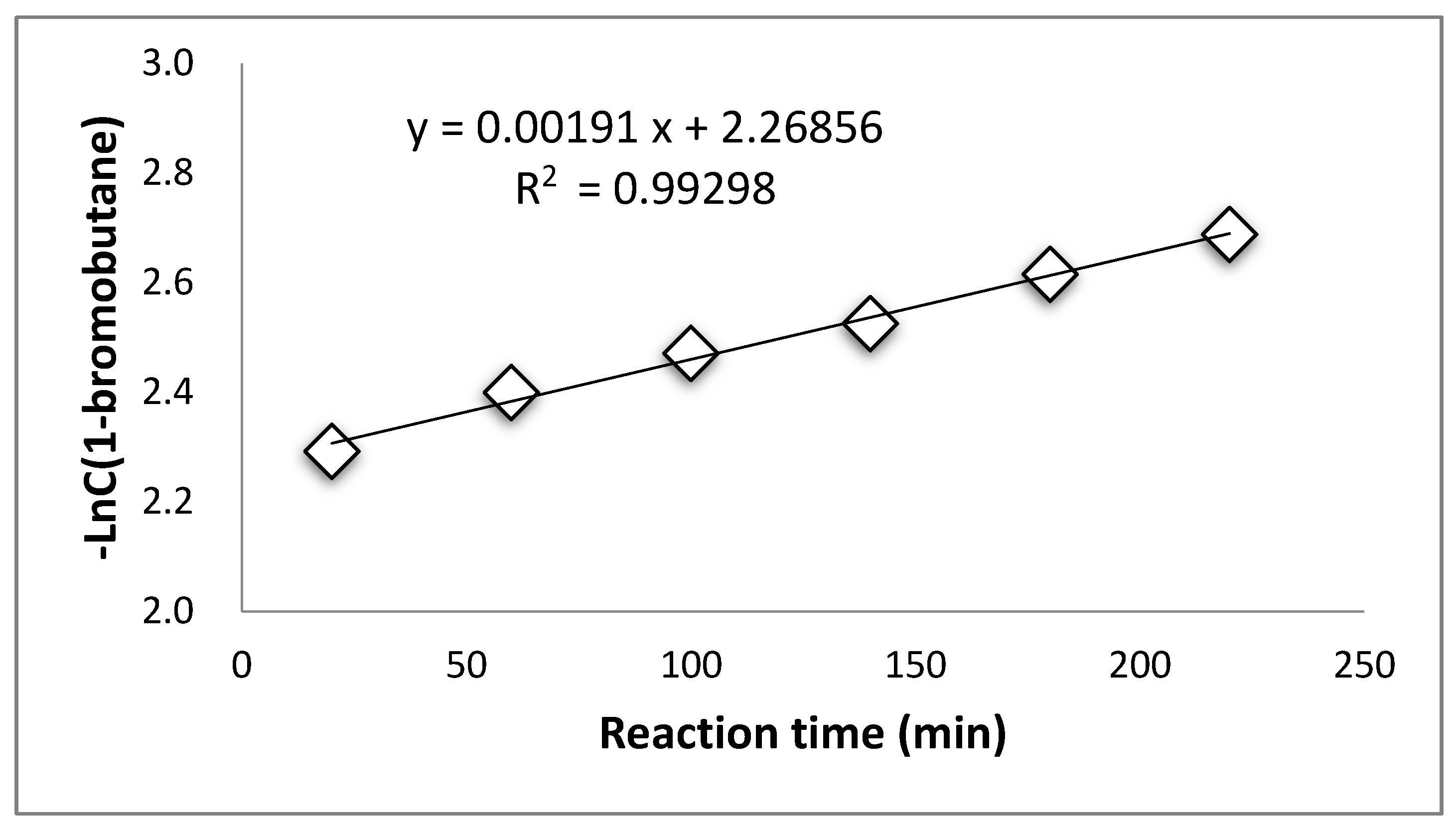
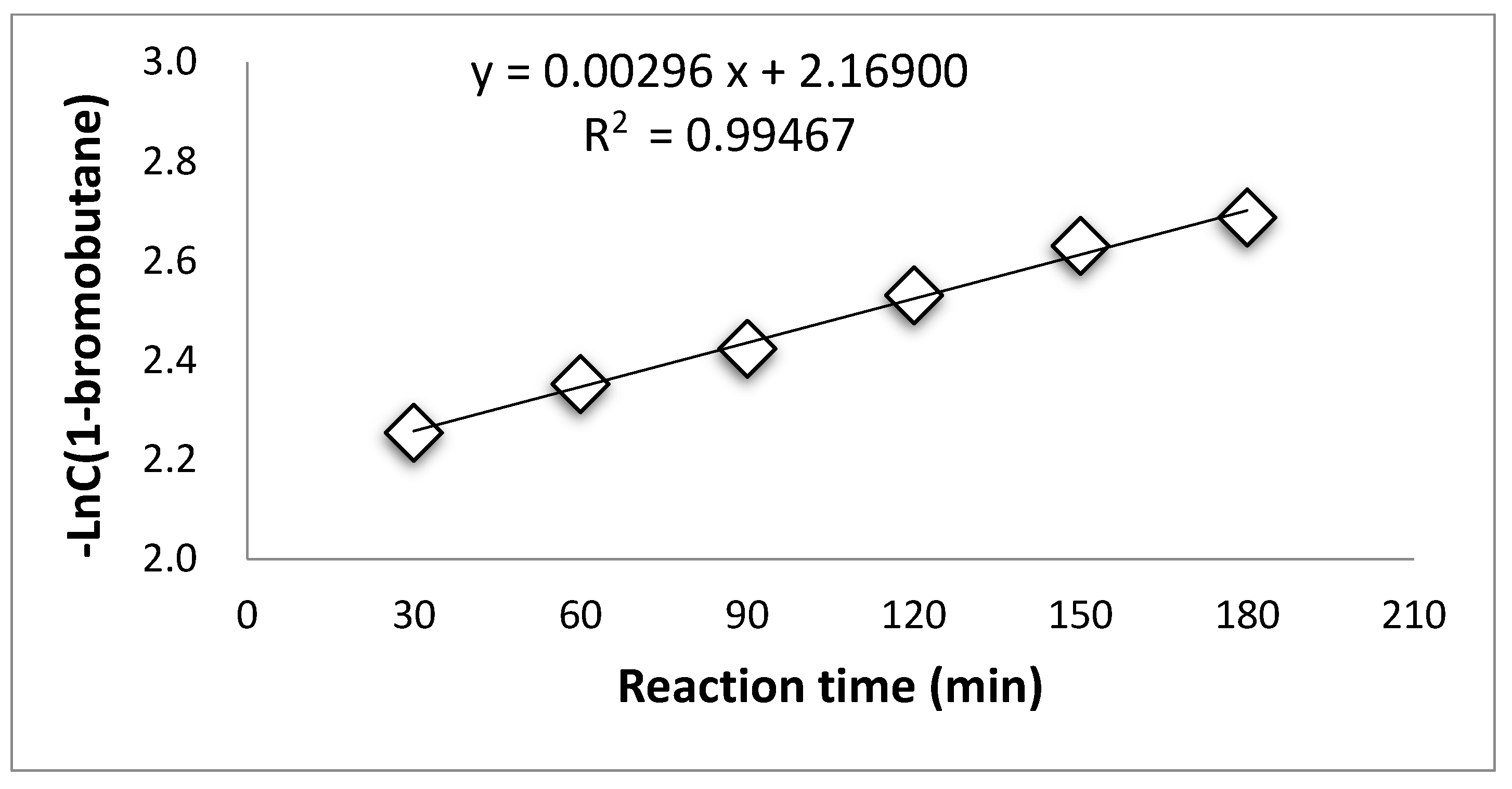
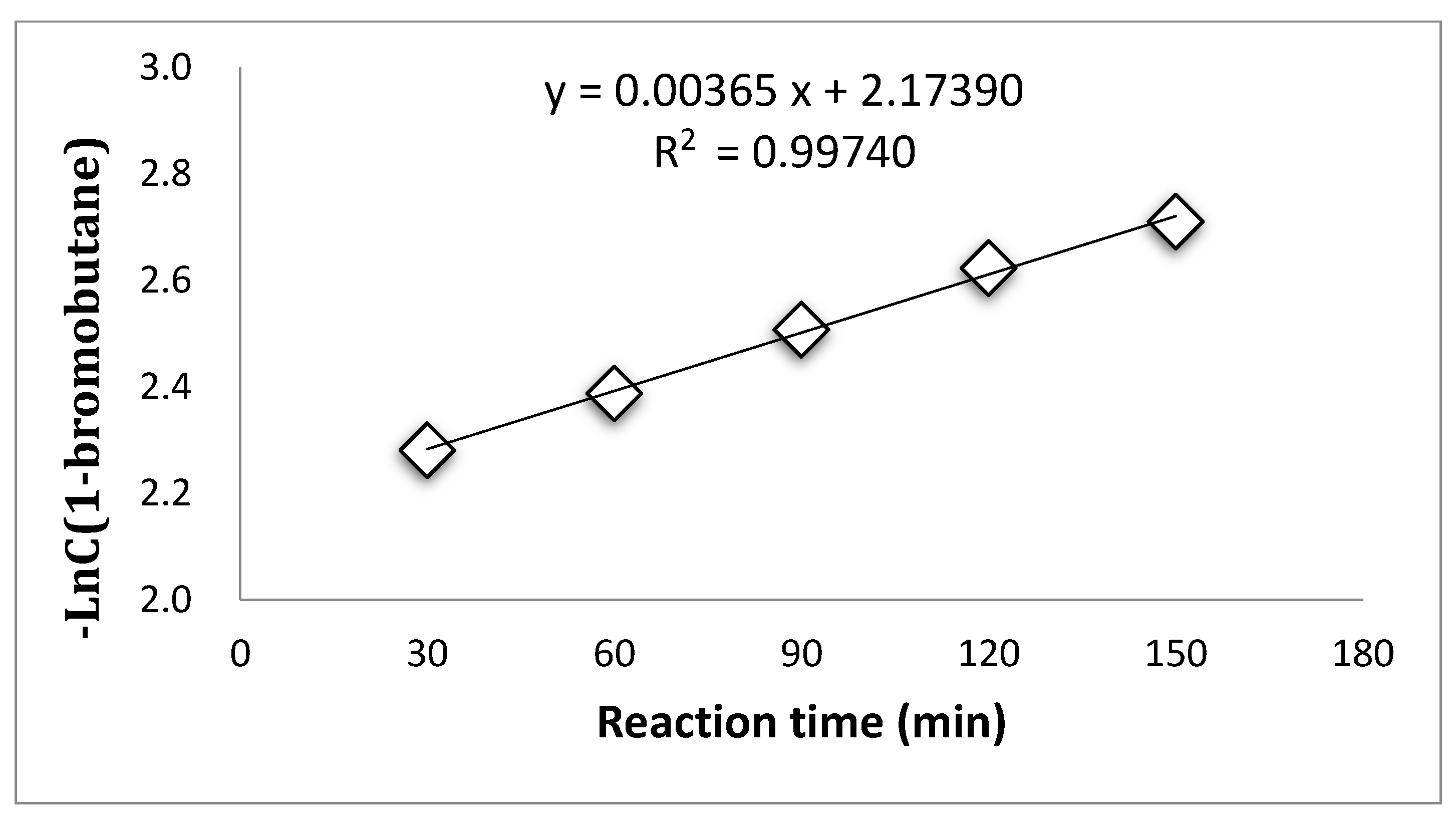
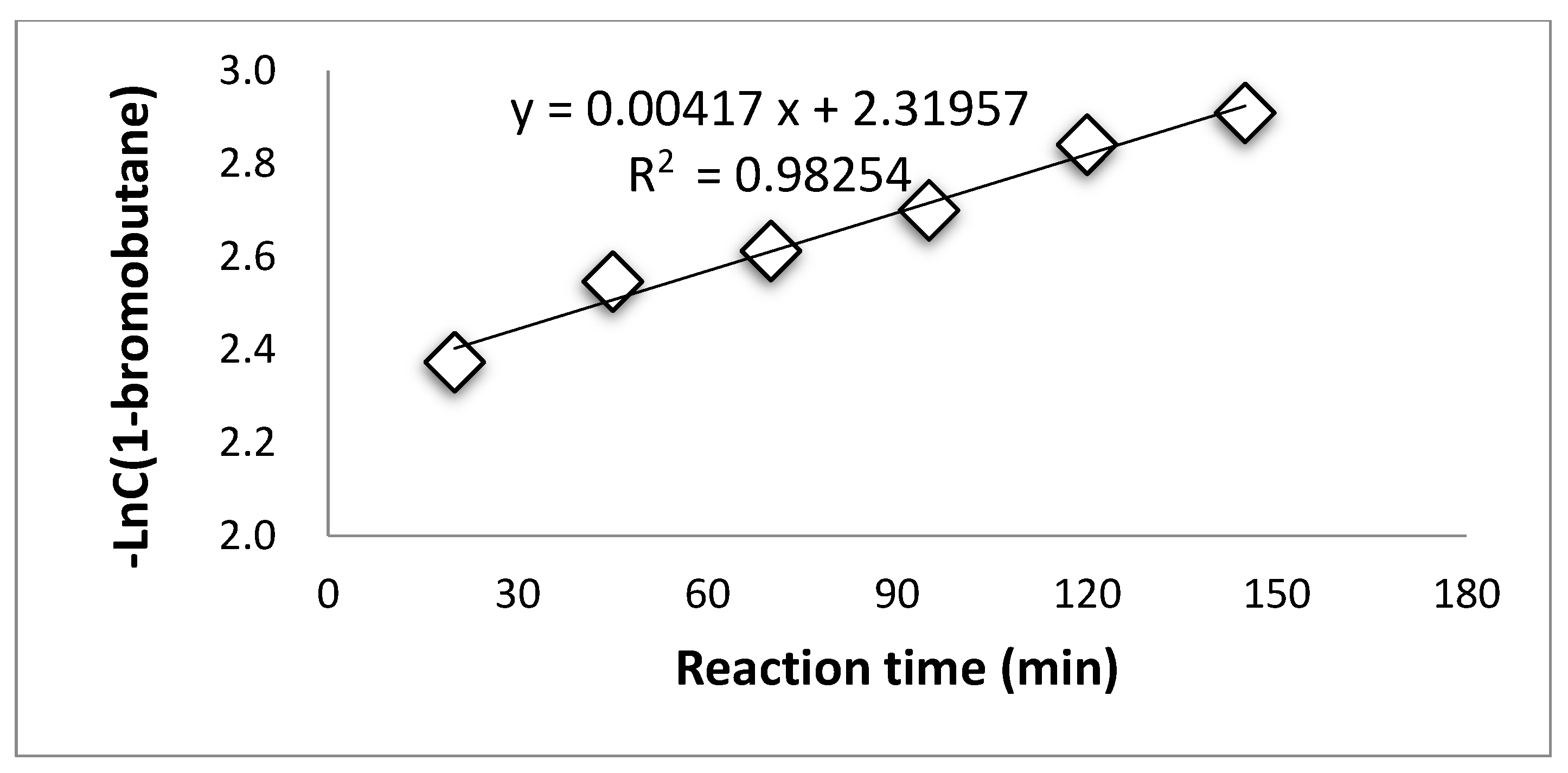
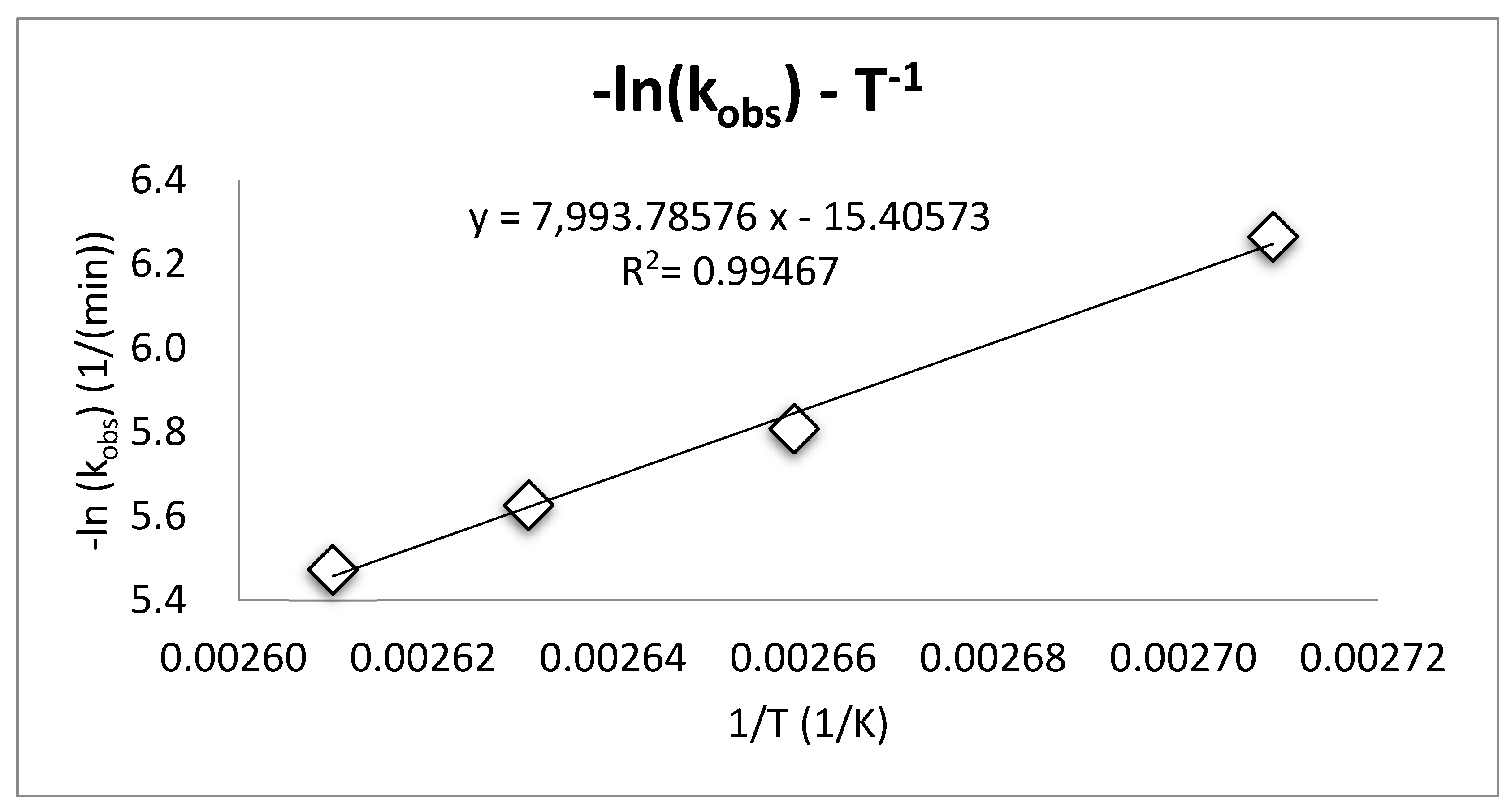
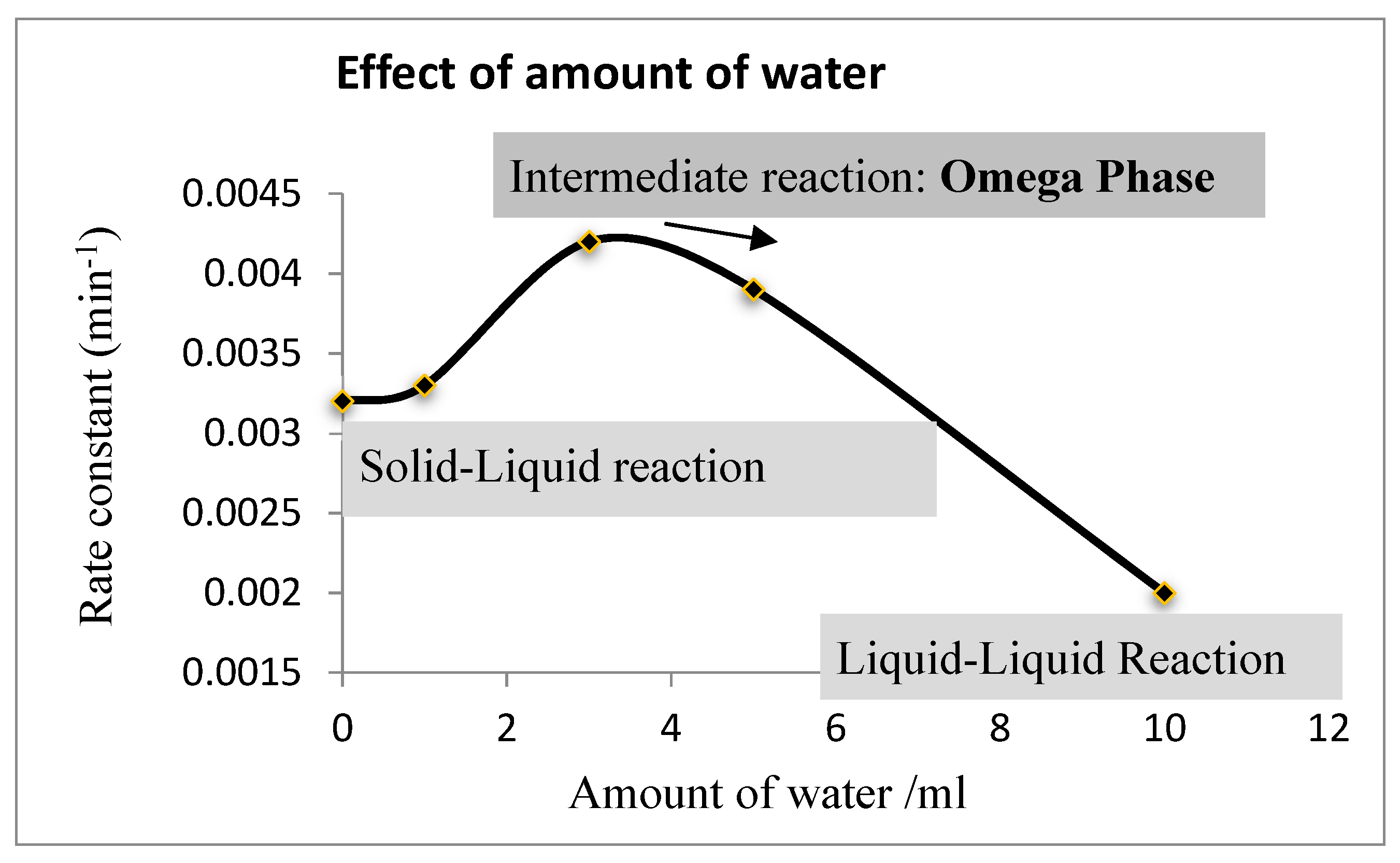
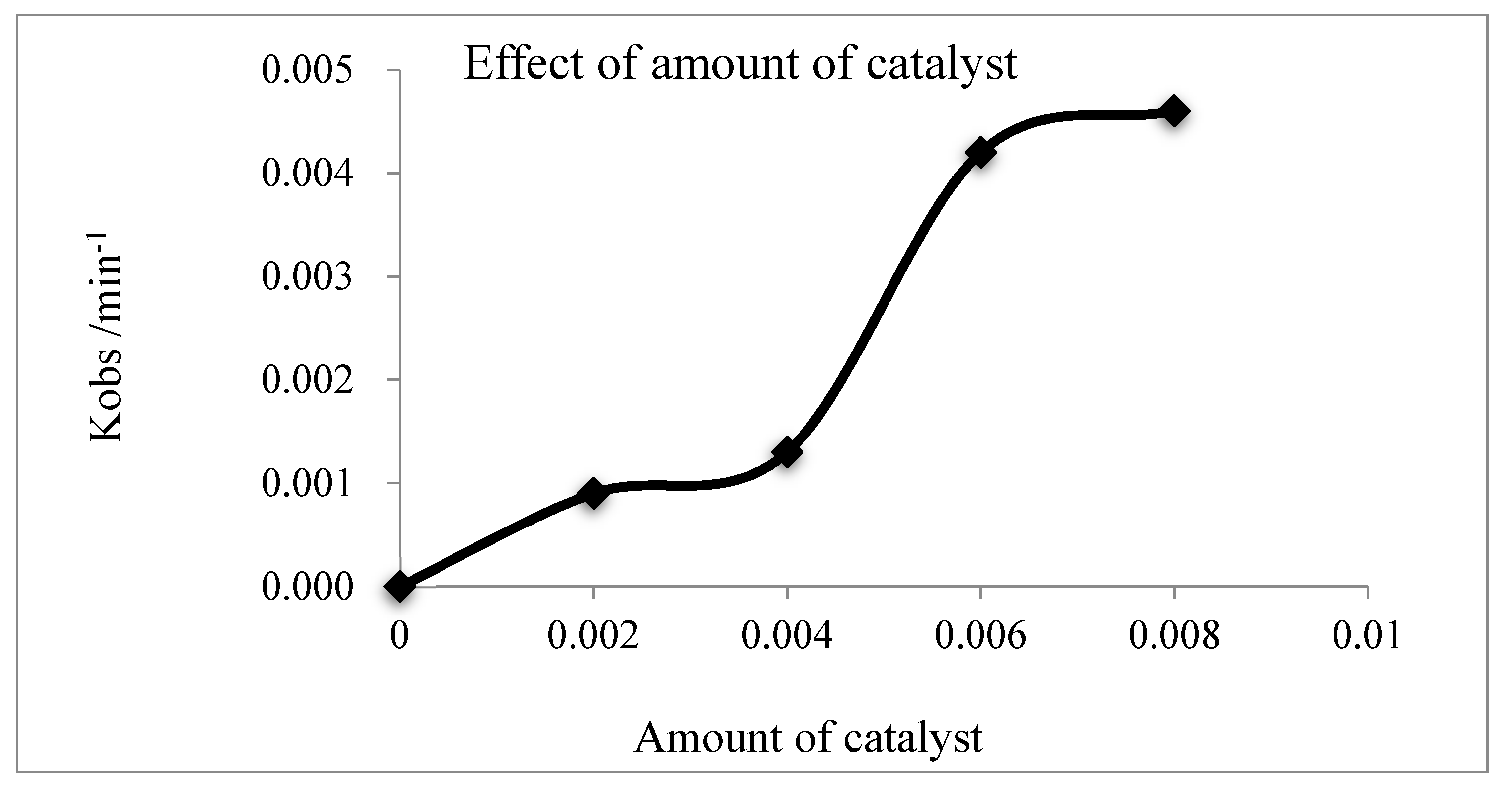
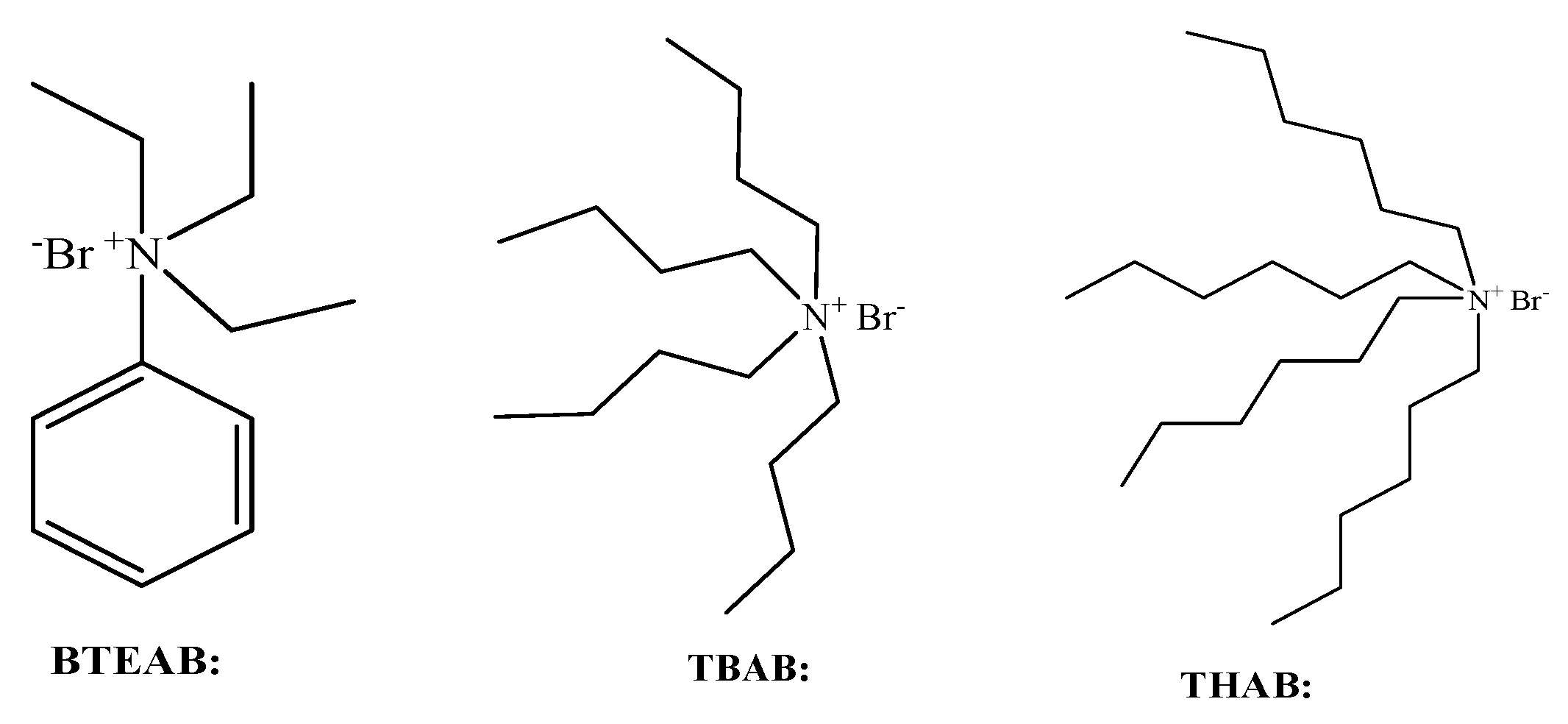

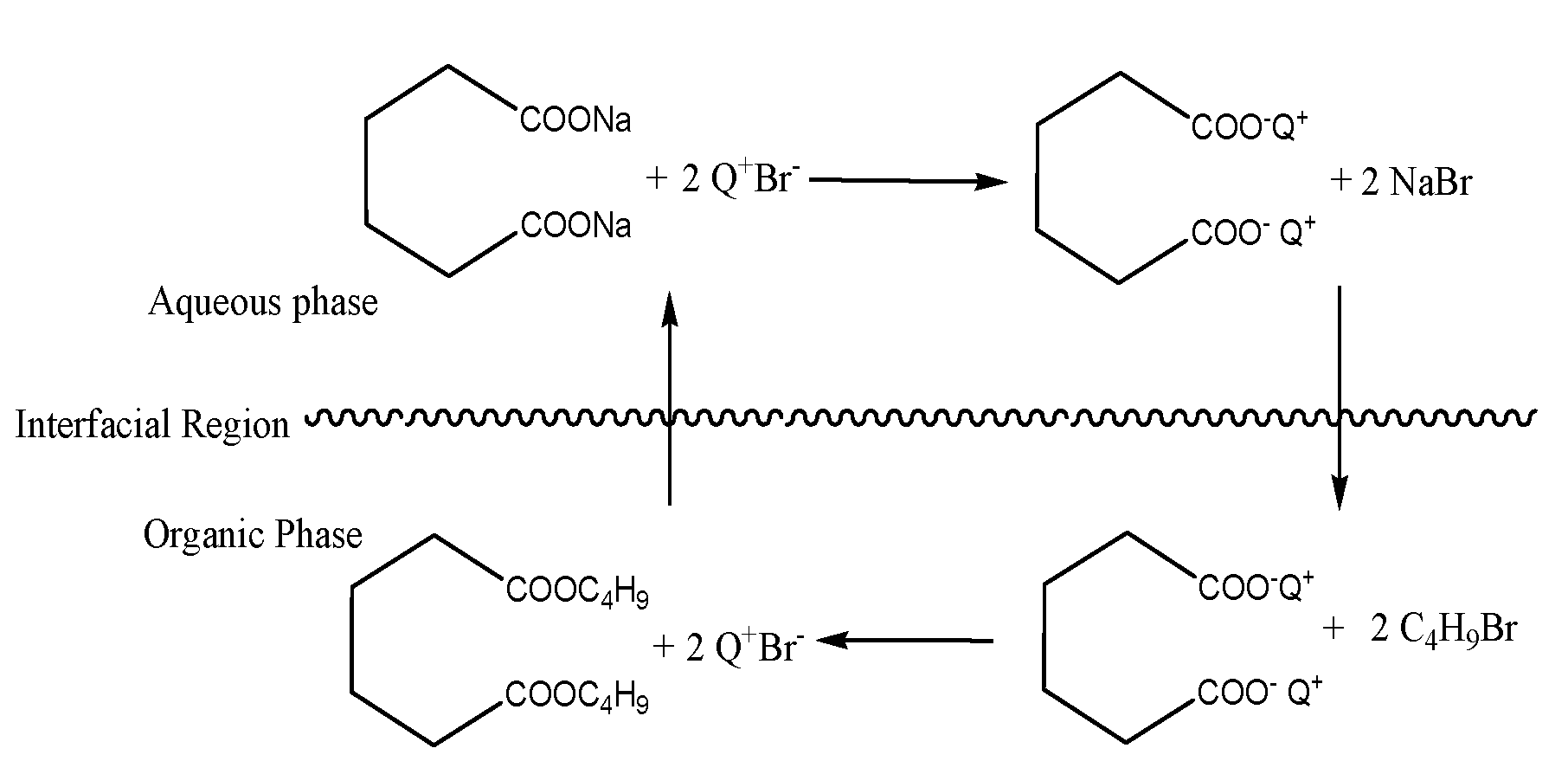

| Catalysts | Reaction Rate (×103) (min−1) |
|---|---|
| THAB | 4.6 |
| TBAB | 4.2 |
| BTEAB | 3.6 |
| Organic Acids | Reaction Rate (×103) (min−1) |
|---|---|
| Adipic acid | 4.2 |
| Phthalic acid | 4.6 |
| Benzoic acid | 5.5 |
© 2019 by the authors. Licensee MDPI, Basel, Switzerland. This article is an open access article distributed under the terms and conditions of the Creative Commons Attribution (CC BY) license (http://creativecommons.org/licenses/by/4.0/).
Share and Cite
Wang, H.; Lin, H.; Li, X.; Ren, R.; Pu, J.; Zhang, H.; Zheng, Y.; Zhao, J.; Ng, S.; Zhang, H. Application of Phase Transfer Catalysis in the Esterification of Organic Acids: The Primary Products from Ring Hydrocarbon Oxidation Processes. Catalysts 2019, 9, 851. https://doi.org/10.3390/catal9100851
Wang H, Lin H, Li X, Ren R, Pu J, Zhang H, Zheng Y, Zhao J, Ng S, Zhang H. Application of Phase Transfer Catalysis in the Esterification of Organic Acids: The Primary Products from Ring Hydrocarbon Oxidation Processes. Catalysts. 2019; 9(10):851. https://doi.org/10.3390/catal9100851
Chicago/Turabian StyleWang, Hui, Hongfei Lin, Xiaohu Li, Rui Ren, Jianglong Pu, Haiping Zhang, Ying Zheng, Jianshe Zhao, Siauw Ng, and Hui Zhang. 2019. "Application of Phase Transfer Catalysis in the Esterification of Organic Acids: The Primary Products from Ring Hydrocarbon Oxidation Processes" Catalysts 9, no. 10: 851. https://doi.org/10.3390/catal9100851
APA StyleWang, H., Lin, H., Li, X., Ren, R., Pu, J., Zhang, H., Zheng, Y., Zhao, J., Ng, S., & Zhang, H. (2019). Application of Phase Transfer Catalysis in the Esterification of Organic Acids: The Primary Products from Ring Hydrocarbon Oxidation Processes. Catalysts, 9(10), 851. https://doi.org/10.3390/catal9100851






